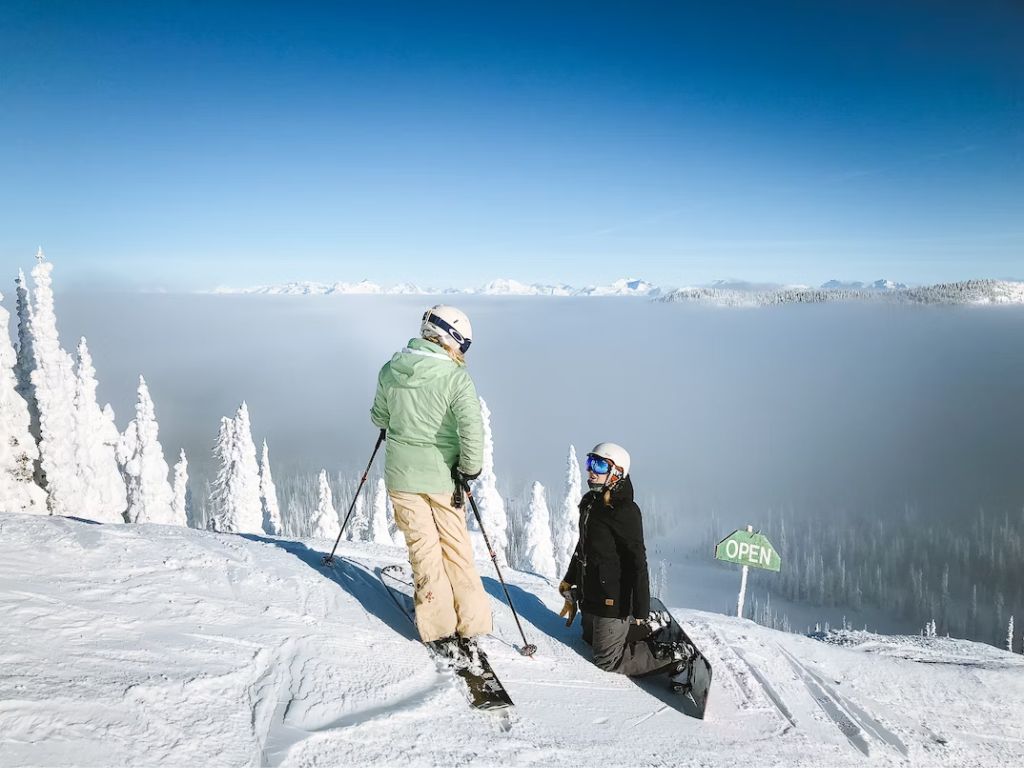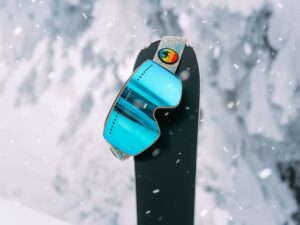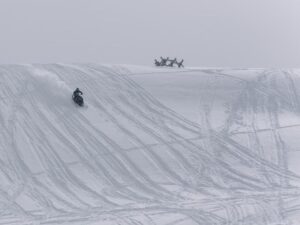As a newbie trying to find their way around the white powder, it’s important to have faith in your choice of equipment, especially skis.
And I believe a good set of skis automatically instills that faith in its rider. For absolute beginners, I recommend renting skis as you’re just getting started.
So, if you’re here, I assume you have had a few ski sessions, enjoyed them, and decided to take up the sport. For that, congratulations! It’s one of the best things about winter, trust me.
Now, let’s talk about what YOU want. You want a balanced and forgiving pair of skis with moderate performance capabilities.
Beginners should avoid high-performance equipment and opt for stable skis that are easily controlled. You want to learn without losing control with every turn. Look for something durable that fits your needs and won’t break your bank.
Top 3 Beginner Skis for Men
| Ski | Saloman QST 92 | Rossignol Sender 90 Pro | K2 Disruption 78 C |
|---|---|---|---|
| Best Suited for | All Mountain | All Mountain | Piste/Carving |
| Waist | 92 mm | 90 mm | 78 mm |
| Lengths Available | 152-184 cm | 150 – 180 cm | 156 – 177 cm |
| Shape | All-terrain rocker with slight camber underfoot | Progressive camber | All-Terrain Rocker with a slight camber underfoot |
| Price | $$ | $ | $ |
| Reasons to Buy | Versatile, Good Reliability, Reputed Brand | Lightweight, Best in Budget | Inherits advanced tech from premium elder models |
| Reasons to Avoid | It may be Pricey for Beginners | Potential durability concerns with budget-friendly build | May lack versatility for certain skiers |
| Where to Buy | Check Price | Check Price | Check Price |
1Editor’s Pick: Saloman QST 92
- Type: All Mountain
- Length: 152 – 184 cm
- Width: 92 mm
- Shape: All-terrain rocker with slight camber underfoot
- Weight: 3.6 – 8.5 lbs/ski
- Flex: Medium
- Price: 549 USD
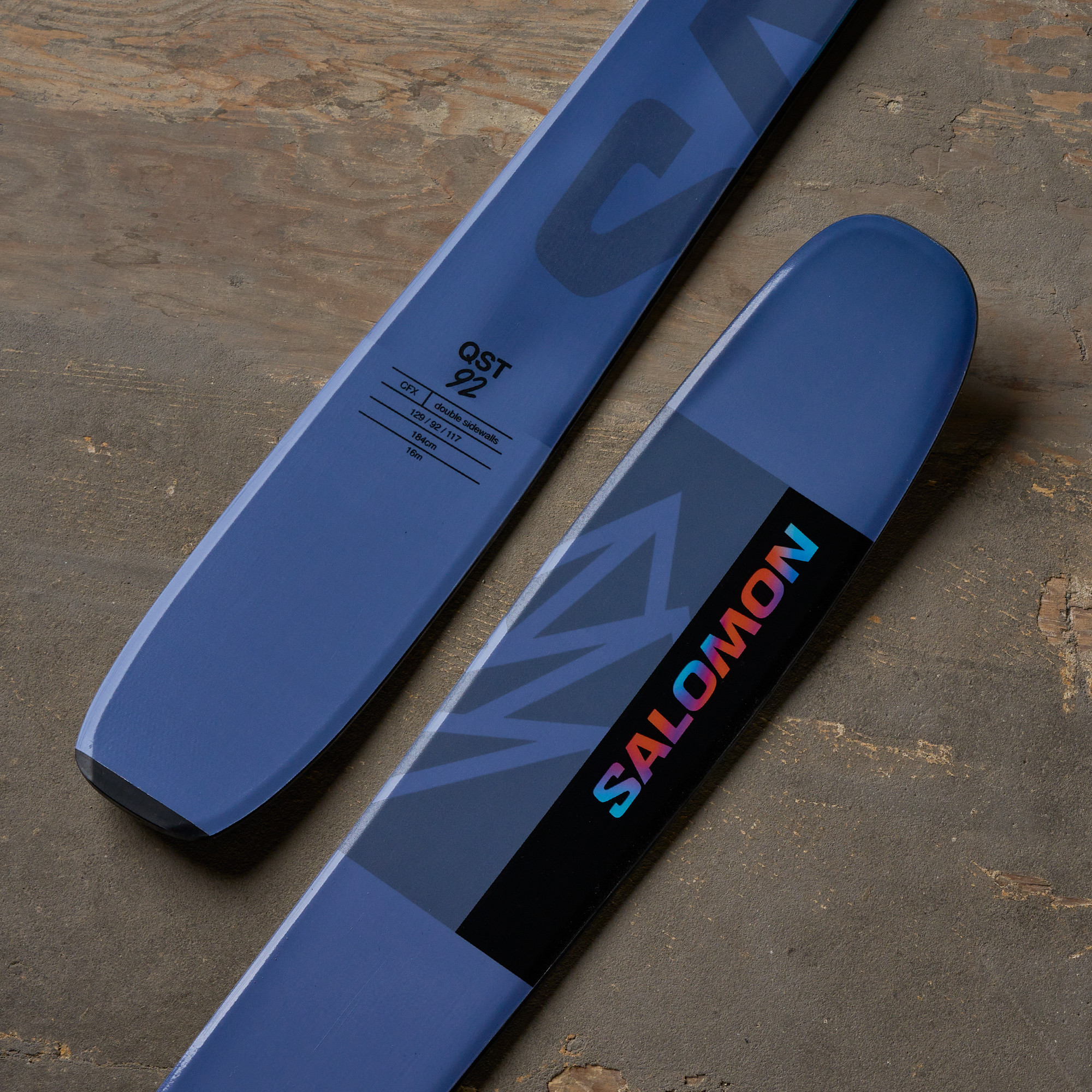
Saloman QST 92
Editor’s Choice
The Salomon QST 92 is the best and most versatile all-mountain ski for beginners. It has a 92mm waist and delivers versatility on groomed slopes and excellent control in softer snow situations.
This model is available in three color schemes: Copen Blue, Safety Yellow, and Neon Green. Its strong edge hold gives the ski reliable stability.
Salomon is a well-known brand for all types of skis, and its reputation for innovation and quality is perfectly reflected in the QST 92.
Truly a solid choice for those who enjoy exploring different aspects of the mountain.
2Budget Choice: Rossignol Sender 90 Pro
- Type: All Mountain
- Length: 150 – 180 cm
- Width: 90 mm
- Shape: Progressive camber
- Weight: 3.5 – 7.3 lbs/ski
- Flex: Medium
- Price: 429 USD
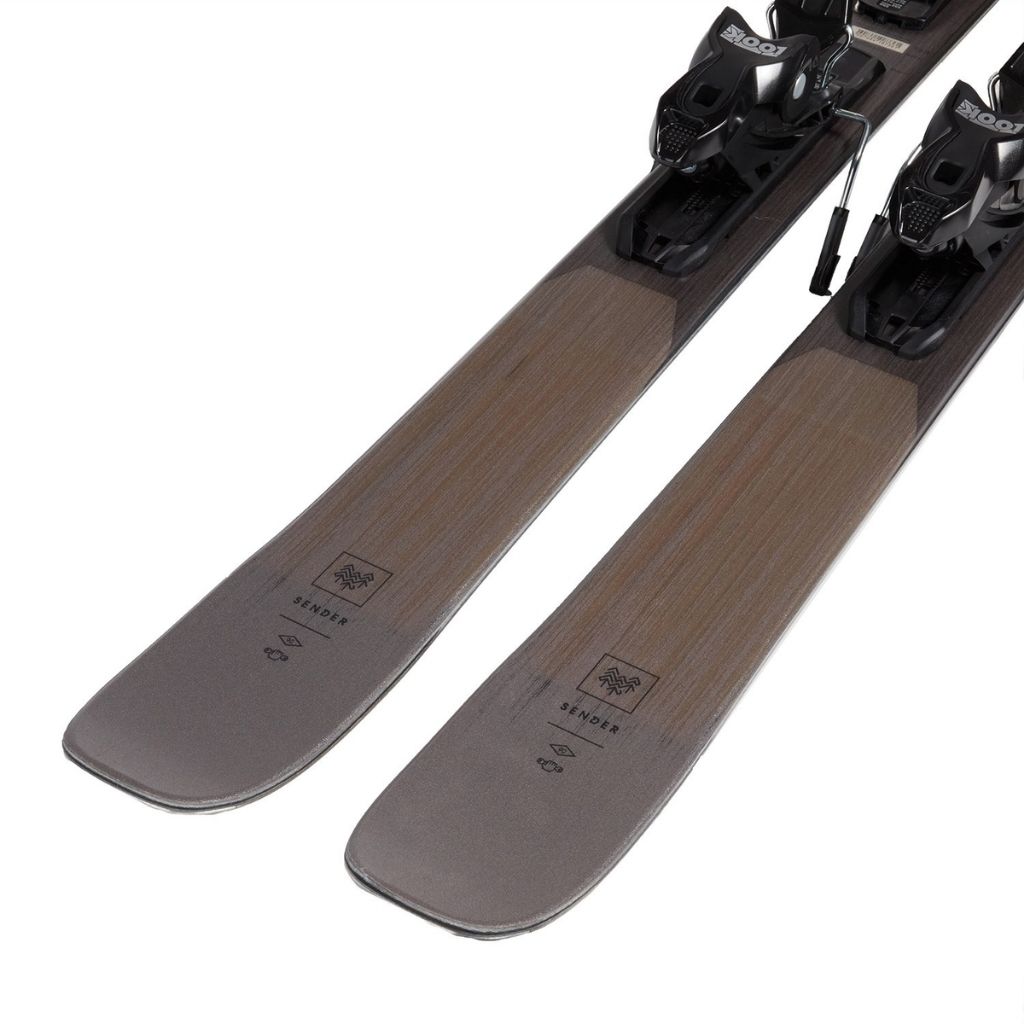
Rossignol Sender 90 Pro
Budget Choice
This lightweight, all-mountain ski from Rossignol is a great option in multiple ways. The Sender 90 Pro is perfect for those looking for one on a budget.
With a medium flex, it’s versatile and responds dynamically to varied terrain. It’s a ski that grows with you as you tackle diverse mountain landscapes.
The secret sauce is the ski’s revolutionary all-terrain transition design. It’s the key to making smooth turns on groomed slopes and navigating off-piste obstacles.
All this is what makes Sender 90 Pro a reliable option for beginners.
3K2 Disruption 78 C
- Type: Piste/Carving
- Length: 156 – 177 cm
- Width: 78 mm
- Shape: All-terrain rocker with a slight camber underfoot
- Weight: 3.6 lbs at 170 cm
- Flex: Medium
- Price: 487 USD
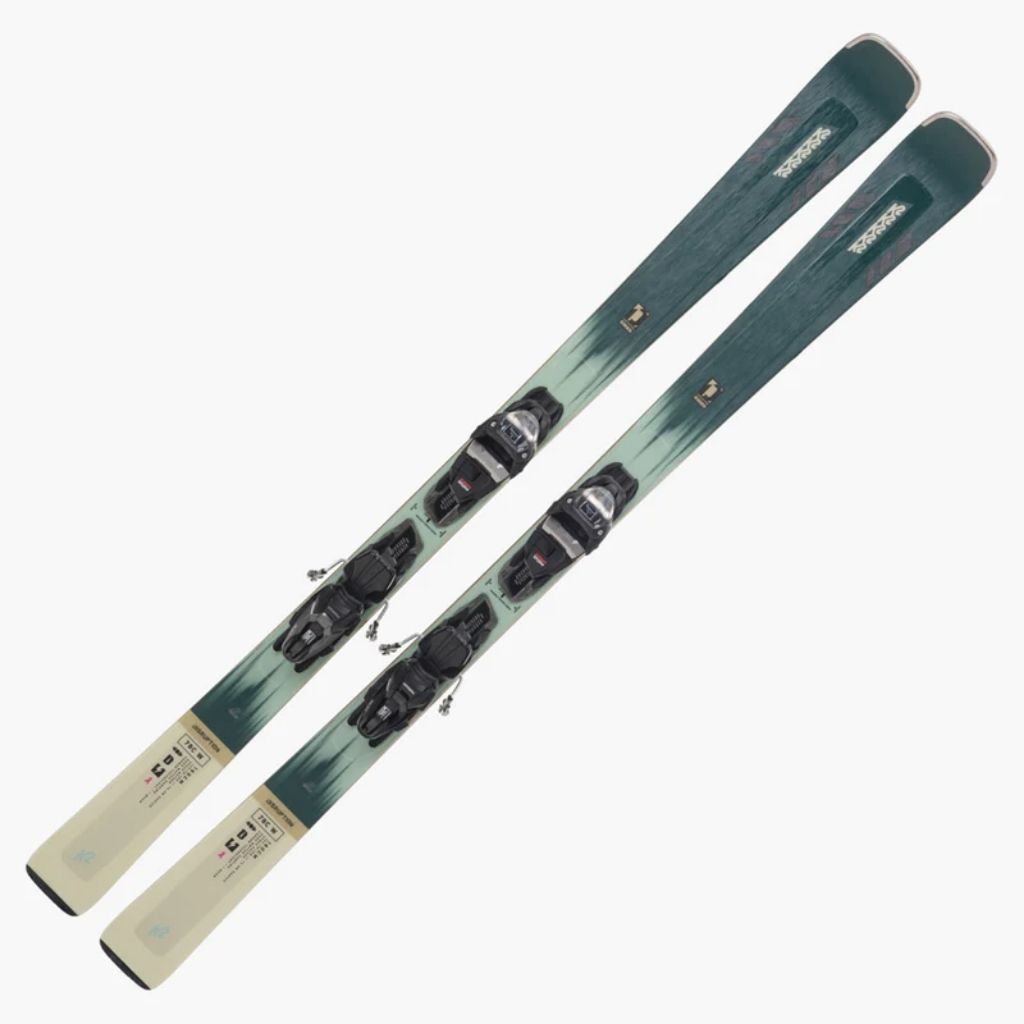
K2 Disruption 78 C
Having carved through slopes with the Disruption myself, it’s the perfect example of high performance with a forgiving spirit.
The Disruption 78C is a super light pair of skis, great for piste and even some all-mountain skiing. This model inherits a lot of fancy tech from its well-known elder siblings and combines them with other top-tier features – all packaged for less than $500!
The Disruption 78C is a speed master, with a Speed Rocker profile, Dark Matter Damping, and the agile touch of K2’s carbon I-Beam construction. It effortlessly keeps up with the finest. It offers every skier a thrilling experience on the piste.
Top 3 Beginner Skis for Women
| Ski | Elan Wildcat 76 | Blizzard Black Pearl 88 | Line Pandora 84 |
|---|---|---|---|
| Best Suited for | All Mountain/Carving | All Mountain/Carving | Piste/Carving |
| Waist | 76 mm | 88 mm | 84 mm |
| Lengths Available | 144-166 cm | 147 – 187 cm | 151 – 165 cm |
| Shape | Amphibio (Rocker/Camber) | TrueBlend Woodcore Technology with a slight rocker/camber combination | Rocker/Camber |
| Price | $$ | $$$ | $ |
| Reasons to Buy | Natural Flex, Light, and Sturdy | Lightweight, Great Control | Best in Budget, Versatile |
| Reasons to Avoid | The specific binding system may limit customization options | Maybe Pricey for Beginners | Might not perform well as you advance your skills |
| Where to Buy | Check Price | Check Price | Check Price |
1Editor’s Pick: Elan Wildcat 76
- Type: All Mountain/Carving
- Length: 144 – 166 cm
- Width: 76 mm
- Shape: Amphibio (Rocker/Camber)
- Weight: ~1.5 lbs/ski
- Flex: Medium
- Price: 600 USD
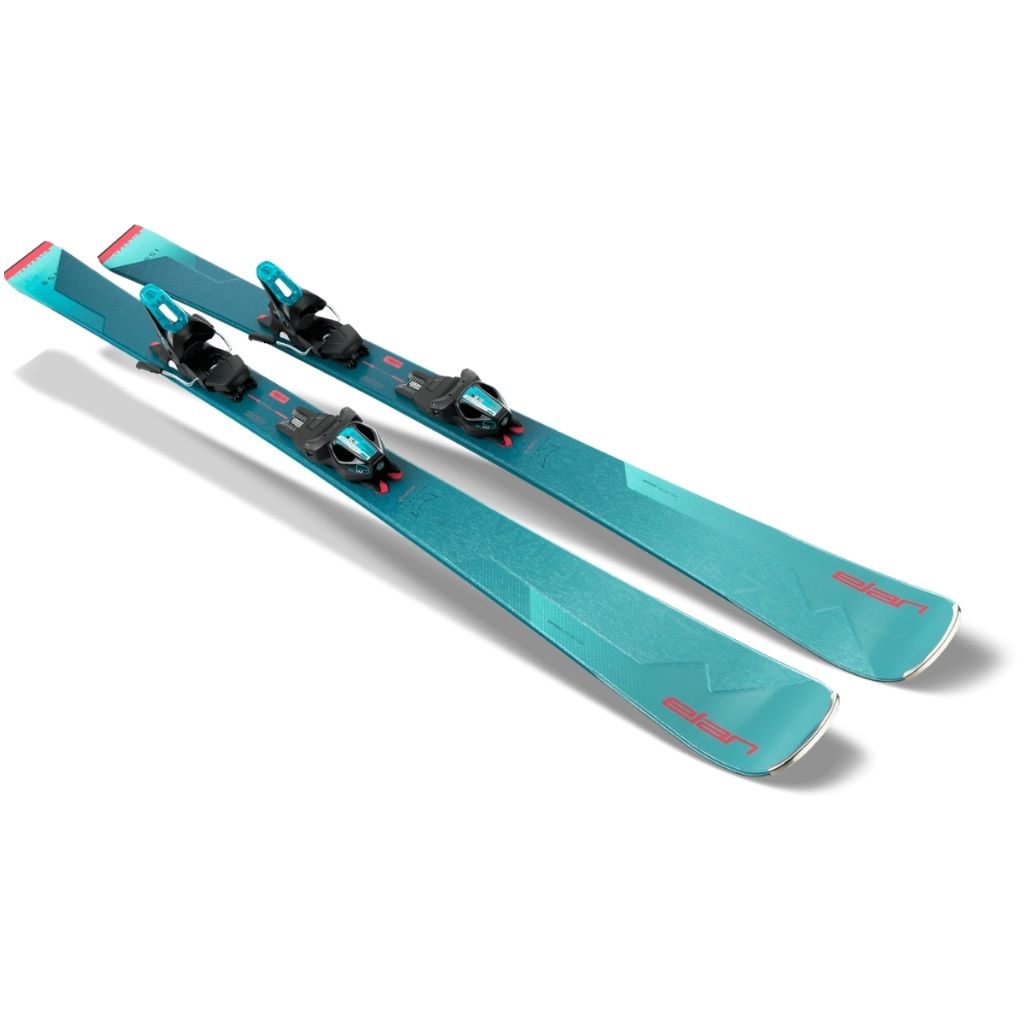
Elan Wildcat 76
Editor’s Pick
The Wildcat 76 is the best beginner ski for women and a go-to for smooth, effortless carving across mountain terrain. This ski will make every turn feel effortless and give you an instant boost of confidence.
Surprisingly light yet incredibly sturdy, the Wildcat showcases impressive engineering. It comes with Light Shift bindings, and this versatile model has a natural flex while being lightweight.
The asymmetrical design aligns with your movements and gives you optimal balance for perfect turns. Last but not least, its Amphibio Profile is a standout feature that integrates a rocker on the outside edge and camber on the inside edge.
2Blizzard Black Pearl 88
- Type: All Mountain/Carving
- Length: 147 – 177 cm
- Width: 88 mm
- Shape: TrueBlend Woodcore Technology with a slight rocker/camber combination
- Weight: ~3 lbs/ski
- Flex: Medium
- Price: 648 – 699 USD
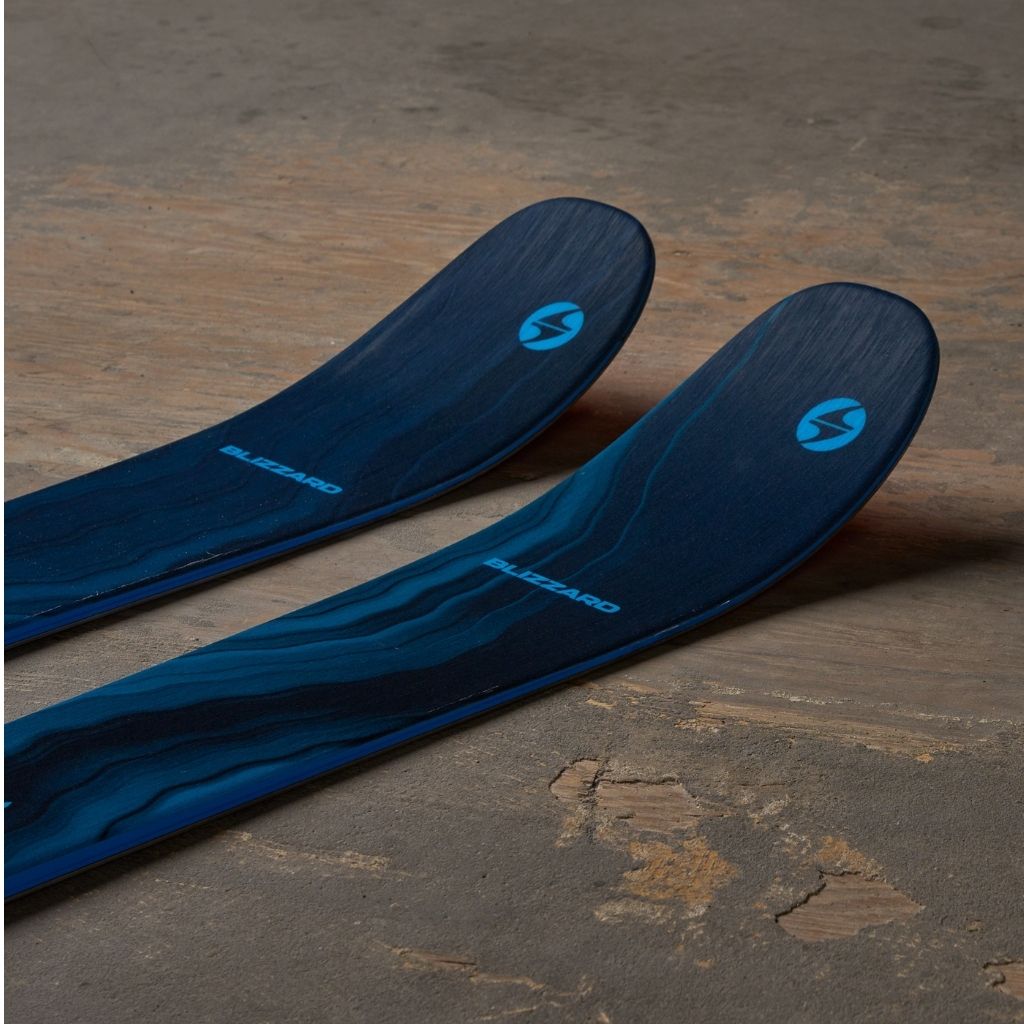
Blizzard Black Pearl 88
The Blizzard Black Pearl 88 Skis have garnered a dedicated following for years, and for good reason. They deliver a ride that’s consistently smooth, balanced, and impressively versatile across variable conditions.
The 2023 iteration of the Black Pearl 88 has been thoughtfully redesigned, integrating ideas from Blizzard’s pioneering Women 2 Women project.
Engineered with a women’s specific TrueBlend Flipcore layup, the Black Pearl 88 skis bring a new level of performance, letting you get the most out of every run.
3Budget Choice: Line Pandora 84
- Type: All Mountain
- Length: 151 – 165 cm
- Width: 84 mm
- Shape: Rocker/Camber
- Weight: ~2.95 lbs/ski
- Flex: Medium
- Price: 342 – 449 USD
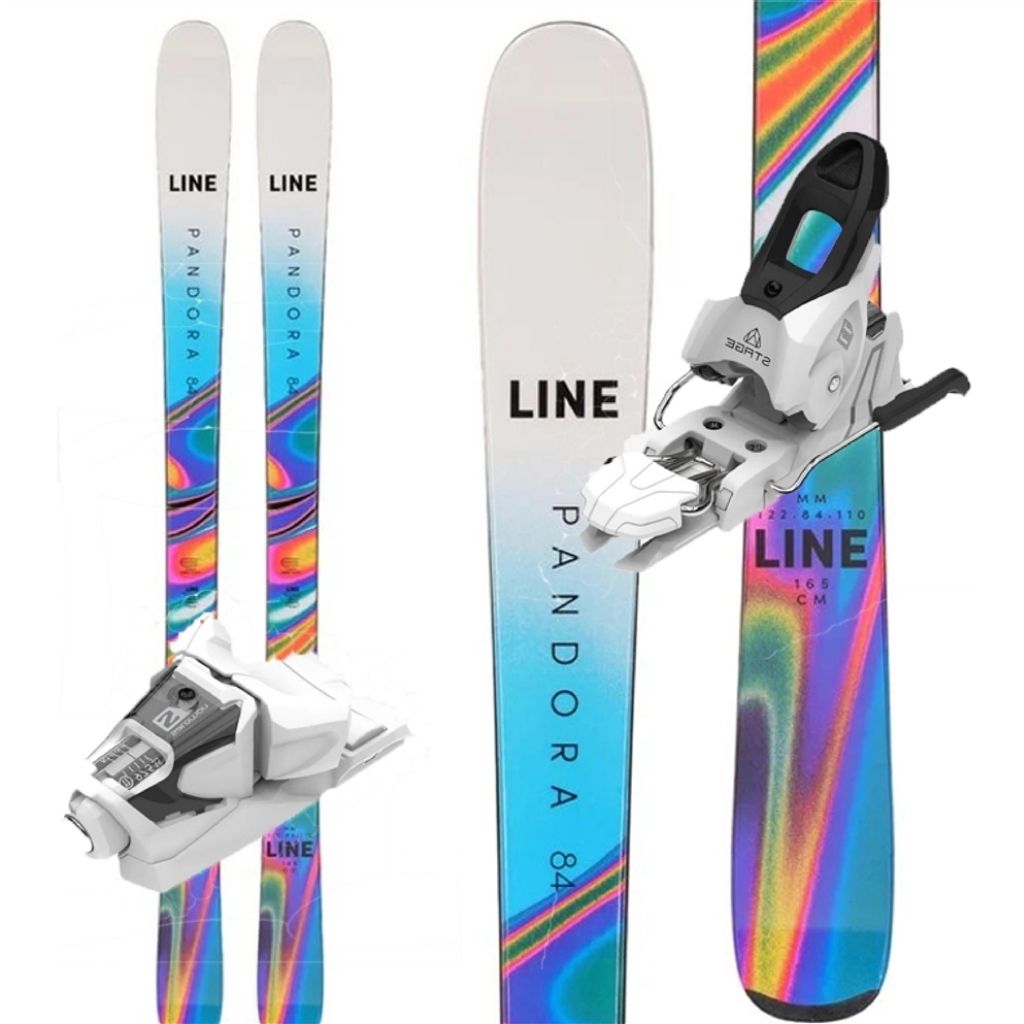
Line Pandora 84
Budget Choice
The Line Pandora 84 skis emerge as a well-rounded package, apt for female riders looking for a beginner ski on a budget.
Its lightness and ease of maneuverability make it the perfect match for seasoned groomer specialists. It’s forgiving for those making the leap from rental skis, but it’s also capable of challenging advanced skiers.
The key to Pandora 84’s versatility lies in its meticulously crafted features. The carefully selected Aspenlight™ core and a proven, even flex contribute to a responsive and reliable skiing experience.
Best Beginner Skis for All Mountain Use
| Ski | Line Blade Optic 92 | Salomon QST 98 | Atomic Maven 86 R |
|---|---|---|---|
| Best Suited for | All Mountain | All Mountain/Freeride | All Mountain |
| Waist | 92 mm | 98 mm | 86 mm |
| Lengths Available | 161-182 cm | 169 – 189 cm | 147 – 161 cm |
| Shape | Tip & Tail Rocker with Camber | All-Terrain Rocker 2.0 with a slight camber underfoot | All-Mountain Rocker with slight camber underfoot |
| Price | $ | $$$ | $$ |
| Reasons to Buy | Good Edge hold, Light and Sturdy | Great Control | Forgiving, smooth turns |
| Reasons to Avoid | A lighter tip easily deflected | Not the lightest ski | Not great for higher speeds |
| Where to Buy | Check Price | Check Price | Check Price |
1Budget Choice: Line Blade Optic 92
- Type: All Mountain
- Length: 161 – 182 cm
- Width: 92 mm
- Shape: Tip & Tail Rocker with Camber underfoot
- Weight: ~3.39 lbs/ski
- Flex: Medium
- Price: 300 – 549 USD
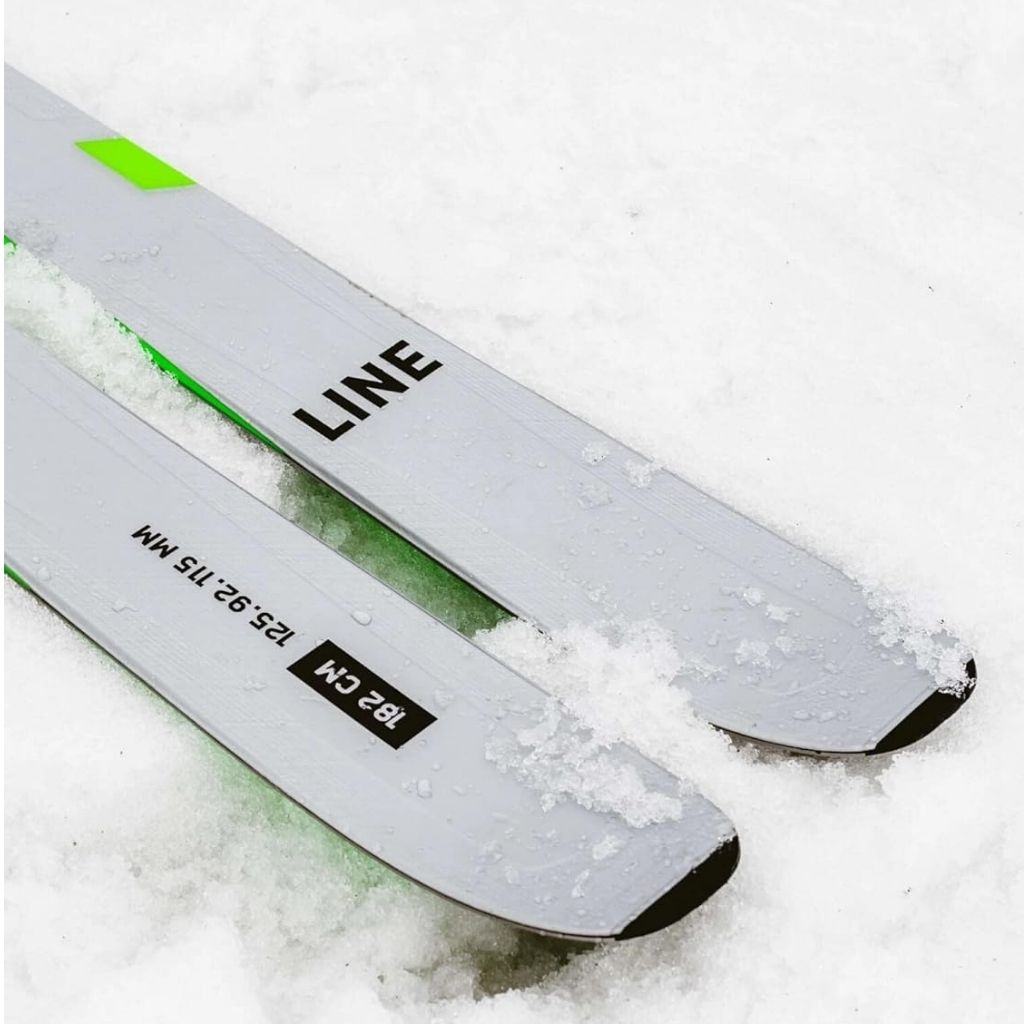
Line Blade Optic 92
Budget Choice
The Line Blade Optic 92 is the best budget all-mountain ski for beginners and experienced skiers. Being the Optic Collection’s narrowest, it is a high-performing ski for riders who like to rally groomers and make the most of a few inches of fresh snow.
Its featherweight construction enhances agility without compromising stability.
When these traits are combined with its cost, this ski is ideal for skiers wishing to make an impression on a hardpack and enjoy a spirited ride through various mountain conditions.
The moderate flex balances stability and maneuverability, allowing you to enjoy a dynamic and controlled experience.
2Salomon QST 98
- Type: All Mountain/Freeride
- Length: 169 – 189 cm
- Width: 98 mm
- Shape: All-Terrain Rocker 2.0 with a slight camber underfoot
- Weight: ~4.34 lbs/ski
- Flex: Medium
- Price: 649 USD
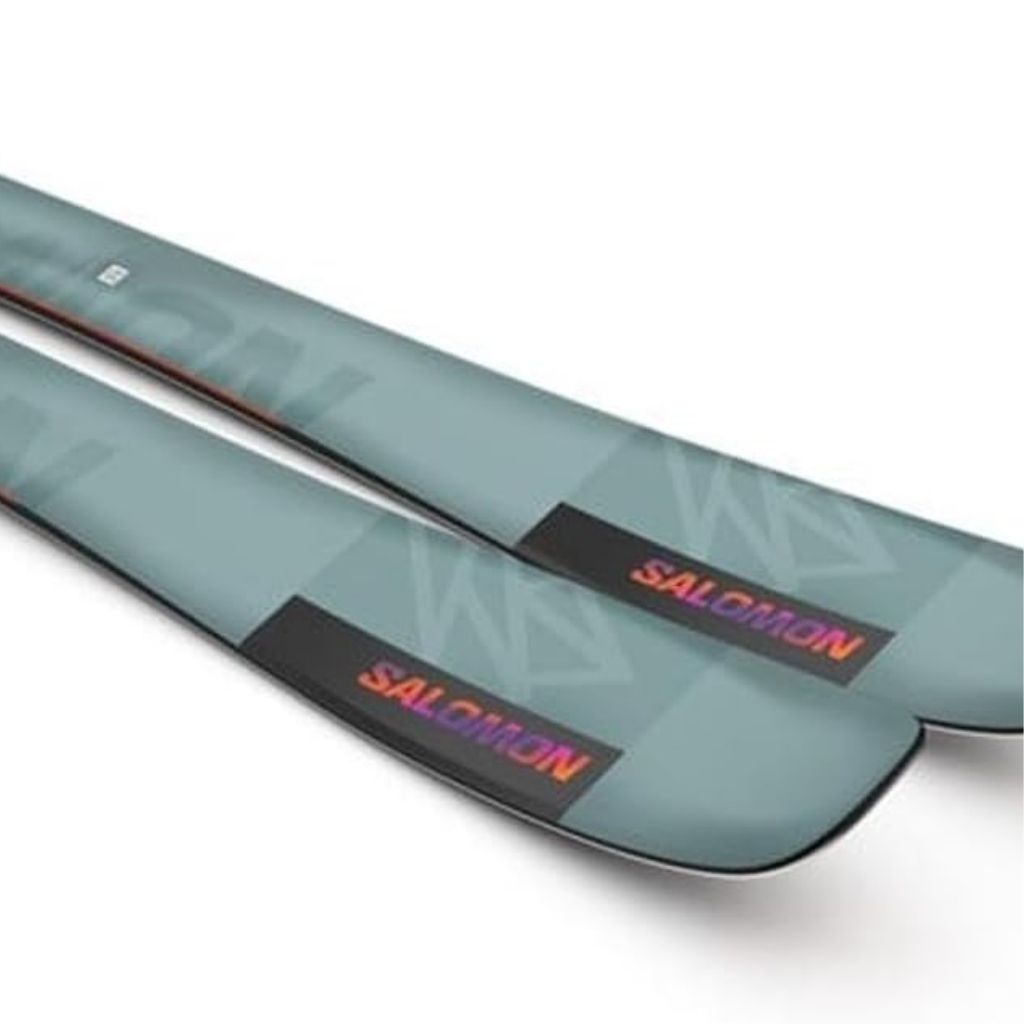
Salomon QST 98
The Salomon QST 98 combines stability, versatility, and a playful feel, ideal for skiers seeking a well-rounded, go-anywhere ski.
Its Freeride Rocker Profile, featuring a 26% tip rocker and 22% tail rocker with camber, provides the ski with a good blend of stability and maneuverability.
Its quick edge-to-edge transitions add to its lively feel. The Full Poplar Woodcore also provides stability and a strong rebound, minimizing vibrations by creating a solid connection with the snow.
3Atomic Maven 86 R
- Type: All Mountain
- Length: 147 – 161 cm
- Width: 86 mm
- Shape: All-Mountain Rocker with slight camber underfoot
- Weight: ~3.34 lbs/ski
- Flex: Medium
- Price: 424 – 617 USD
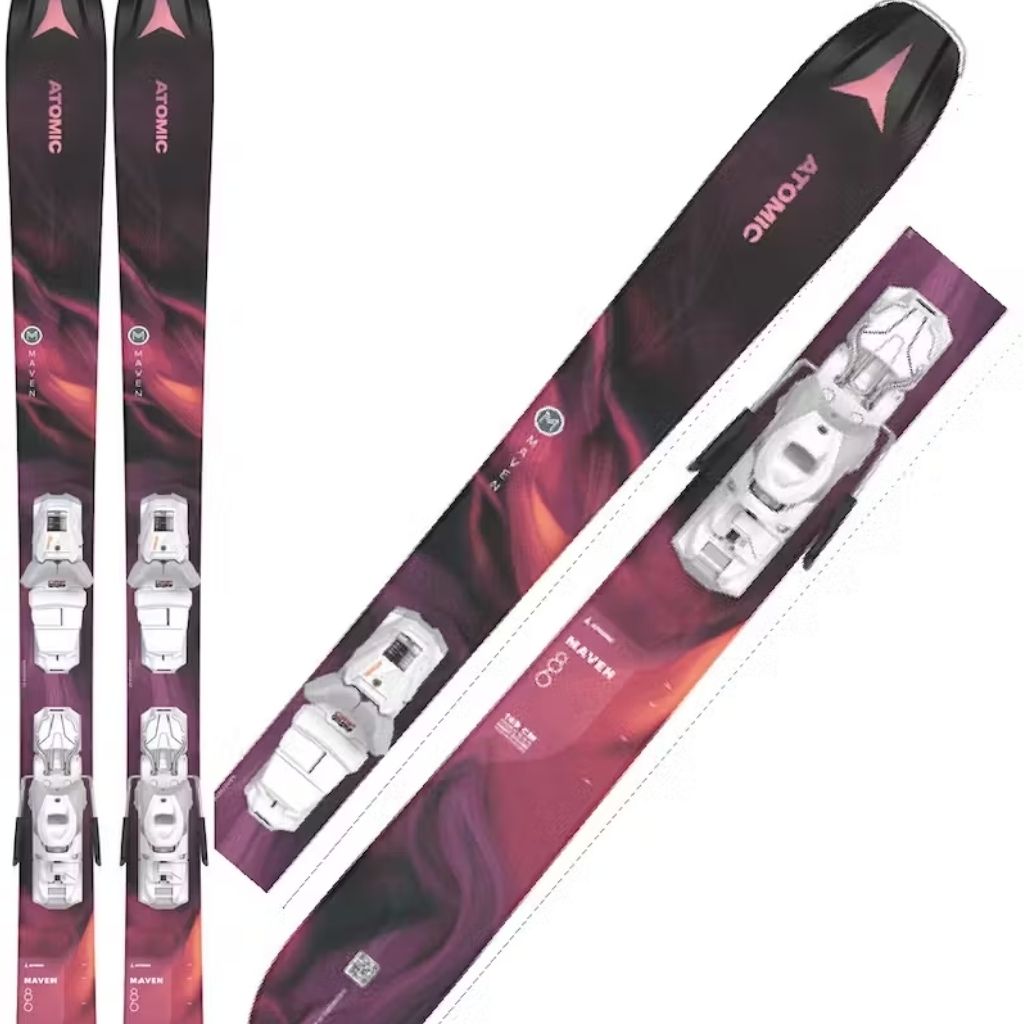
Atomic Maven 86 R
The Atomic Maven 86 R is a solid choice in the all-mountain category. It features the Dura Cap Sidewalls, which provide an excellent edge grip and also add to its durability.
Sporting a vibrant Blue/Bright Red design, this ski catches your eyes and grabs your attention with its unparalleled performance.
The All-Mountain Rocker with a hint of camber underneath strikes the perfect shape balance, making it equally at home on groomed corduroy as it is in the playful nooks of off-piste adventures.
But what truly sets the Maven 86 C apart is the HRZN tech in the tip. It helps you effortlessly float through the powder snow.
How to choose the right ski for yourself?
1. Budget
Consider setting a budget before making the purchase. As a beginner, you shouldn’t splurge on the top-of-the-line model. You shouldn’t go for the cheapest low-quality option either.
Striking a balance between quality and affordability is key.
Generally speaking, a good entry-level ski can typically range from $350 to $500, while intermediate skis with enhanced features may lie within the $500 to $800 range. High-performance or specialty skis can easily surpass the $800 mark.
2. Terrain Type & Skiing Style
Different terrains require different skis, and matching your equipment to the conditions can make or break your skiing experience.
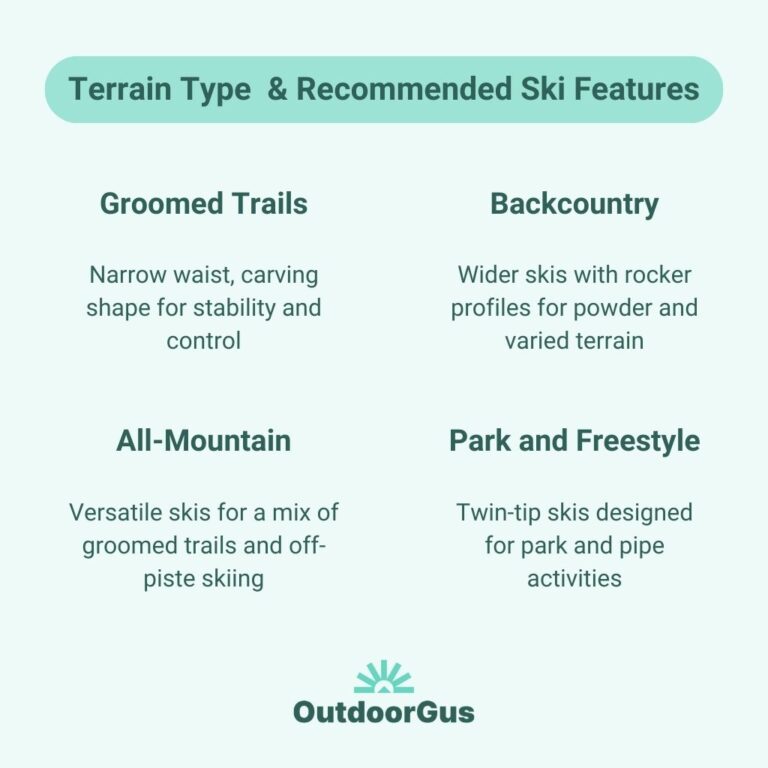
1. Groomed Trails
Skis with a narrower waist and a carving shape are great for resort skiing, where you’ll usually find groomed trails. Such skis excel in stability and control.
2. Off-piste/Backcountry
For backcountry adventures, you need skis with a rocker profile. It will keep you afloat in deeper snow and allow you to easily maneuver in ungroomed terrain.
3. All-Mountain
If you’re like me and enjoy a mix of groomed trails and backcountry exploration, opt for versatile all-mountain skis. They provide a nice blend of stability and performance.
4. Park and Freestyle
Freestyle enthusiasts should choose skis designed for park and pipe activities. Look for twin-tip skis that allow easy backward skiing and provide stability during jumps and tricks.
3. Ski Length
For beginners, shorter skis are better. They’re easier to control and maneuver. Unbeknownst to many, your ideal ski length depends on your height.
If you’re 5’2″ to 5’6″ tall, you should opt for skis with shorter lengths (150 cm to 165 cm). For riders with medium height, between 5’6″ and 6’0″, a moderate ski length (165 cm to 180 cm) is your ideal choice. Taller skiers, standing at 6’0″ and up, should go for the 180 cm to 195 cm range.
Of course, these are general guidelines, and personal preferences play a key role. If you love the quick turns and lively feel of shorter skis, regardless of your height, go for it!
Pro Tip: Don’t be tempted to pick longer skis because they make you look better. I know the feeling, but it will hinder your progress.
4. Underfoot Size
An underfoot size of 80mm to 90mm is generally ideal for beginners. But, as you gain experience, the ideal underfoot size for skis can vary based on the terrain you plan to conquer.
- Groomed Slopes: 75mm to 85mm
Narrower skis enhance edge-to-edge quickness and responsiveness. They’re perfect for carving precise turns on well-groomed slopes.
- All-Mountain (Versatile Terrain): 85mm to 95mm
A slightly wider underfoot balances stability on groomed runs and enough floatation for varied conditions, including light powder.
- Powder and Backcountry: 95mm and above
Wider skis with over 95mm underfoot offer better floatation in deep powder. They provide stability and keep the ski from sinking.
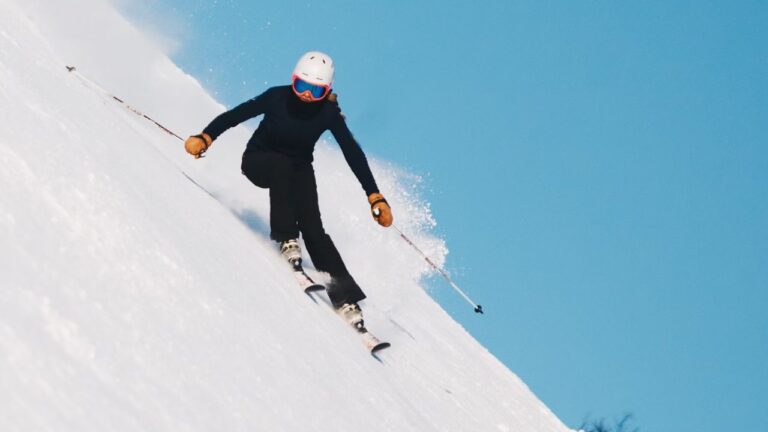
5. Ski Width
When choosing ski width, you’ll need to think about your preferred terrain and the type of skiing you enjoy the most.
Skis with a slightly wider waist, ranging from 80mm to 100mm, provide better stability. As a beginner, you’ll want something forgiving that won’t punish you for the inevitable wobbles as you get your snow legs.
Here’s a quick table for your reference:
| Gender | Height | Weight | Skill Level | Ski Width (mm) |
|---|---|---|---|---|
| Male | < 5’6″ | < 140 lbs | Beginner | 85-95 |
| Intermediate | 95-105 | |||
| Expert | 100-110 | |||
| 5’6″ – 5’10” | 140-175 lbs | Beginner | 90-100 | |
| Intermediate | 100-110 | |||
| Expert | 105-115 | |||
| > 5’10” | > 175 lbs | Beginner | 95-105 | |
| Intermediate | 105-115 | |||
| Expert | 110-120 | |||
| Female | < 5’4″ | < 120 lbs | Beginner | 80-90 |
| Intermediate | 90-100 | |||
| Expert | 95-105 | |||
| 5’4″ – 5’8″ | 120-150 lbs | Beginner | 85-95 | |
| Intermediate | 95-105 | |||
| Expert | 100-110 | |||
| > 5’8″ | > 150 lbs | Beginner | 90-100 | |
| Intermediate | 100-110 | |||
| Expert | 105-115 |
6. Ski Shape / Profile
You’ll often come across the terms “rocker” and “camber.”
A rocker profile means the tips of the skis curve upwards, making turns smoother and preventing those pesky tip-catching moments. Conversely, Camber refers to the slight arch underfoot, enhancing stability and edge grip.
Pro Tip: A ski with a combination of rocker at the tips and camber underfoot is a solid choice for beginners.
7. Flex and Stiffness
Softer flex ensures a forgiving and playful experience, perfect for those still mastering the white powder. But if you want more stability and control at higher speeds, go for a stiffer ski.
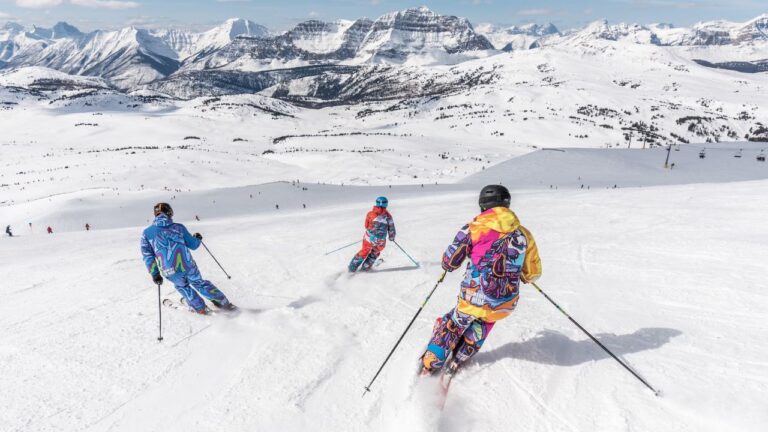
Finding skis with a forgiving flex was a game-changer for me when I started. Because these skis bend more, they make it easier to follow the flow of the slopes.
8. Ski Weight
Ski weight contributes to your skiing performance, too.
- Lighter skis (under 3.5 lbs) offer agility for beginners,
- medium-weight skis (3.5-4.5 lbs) balance stability and maneuverability, and
- heavier skis (over 4.5 lbs) provide power and control for advanced skiers.
Expert QnA
Q. What is a good ski turn radius for beginners?
Skis with turn radius ranging from 15 to 20 meters are generally recommended for beginners. This range balances stability and maneuverability, making it easier for novice skiers to make turns and gain confidence on the slopes.
Skis with shorter radius (closer to 15 meters) are responsive yet forgiving. As you progress, you can switch to skis with a slightly longer turn radius for increased stability at higher speeds.
Q. How often should I wax my skis?
As a general guideline, you should wax your skis every 4-6 skiing days or whenever you notice a decrease in performance. Waxing your skis is absolutely crucial for maintaining base quality. The frequency, however, depends on factors such as the snow type, your skiing style, and how often you hit the slopes.
Additionally, more frequent waxing may be necessary for skiing on abrasive or wet snow.

